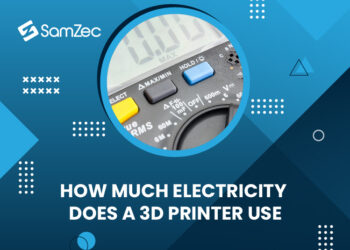A 3D printer’s filament melts and exits out the nozzle, however it might become trapped and clog the machine. If your filament is stringy or won’t pass through the nozzle, it’s time to clean it. You have the option of pushing the clog out while the nozzle is still attached to the machine or completely removing it for a full cleaning. When you’re through, your printer should be in excellent working order! Read this article to learn How to clean 3d printer nozzle.
The Common Clogged Nozzle Scenario
Extruder nozzles are often blocked with a low amount of residue or built-up printing stuff, which may be easily cleaned out using a small analysis or even a thin wire. However you have to be careful, wires can damage the nozzle’s inner walls, so remain vigilant. Professionals in the field advocate cleaning with something that won’t scratch, and for many, that item is a guitar string, which is strong enough to stand up to the clog without harming the nozzle.
The best way to Clean your 3D Printer’s Extruder Nozzle
There are a few simple steps you can take to clean your 3D printer nozzle and get back to printing great-looking objects!
- Depending on your printer, you may need to remove the nozzle before cleaning can begin; if this is the case, do it promptly.
- Next, if your filament isn’t extruding correctly, immerse the nozzle in acetone for 10–20 minutes to remove any inner ick that’s blocking things up.
- After the acetone soak, place the extruder nozzle on a stone and flame it for around 60 seconds. When the tip changes color from black to orange, you’ve been burning it long enough to be very cautious not to touch it.
- Clean up the nozzle aperture using a guitar string or something similar, then repeat the acetone soak and torching operation if the wire won’t fit.
Preventing future nozzle jams
When it comes to 3D printer jams, common sense must prevail, therefore it’s critical to observe what’s going on before one occurs. That requires keeping a tight check on your filament, but more importantly, knowing and comprehending the anatomy of your particular printer. While clogs are a common problem, the location of obstructions in the nozzle varies from machine to machine.
The filament will extrude into the air and not adhere to the bed if the distance between the filament and the nozzle is set correctly. Similarly, if the filament is too low, it will not flow correctly, resulting in retrograde extrusion and, as a result, a jam. You could also check to see if your printer isn’t overheated. Running at the proper temperature is critical, and understanding what temperature to use is part of getting to know your printer.
3D Printer Jam Types and How to Avoid them
In one sort of blockage, your hotend is too cold, preventing your filament from extruding at the proper speed or even at all.If your hotend is too hot, it may not instantly cause a clog in the nozzle, but it may create a “creep,” which is a progressive blockage that takes a long time to clear with acetone or any other cleaning solution.
To avoid this, make sure your filament is properly loaded into the 3D printer and that the external area of the extruder is under minimum stress. You’ll want to make sure the filament spool can spin freely and is correctly positioned to keep it that way. Finally, ensuring that your print bed is fully level will assist to prevent clogs before they occur by ensuring that your printer’s calibration is exact.
Conclusion:
Nozzle cleaning is a method that is necessary to maintain printing quality and enable for the production of excellent and consistent components with smooth surfaces, free of cavities and bumps. Service your equipment on a regular basis or seek expert assistance. We hope you enjoyed this blog and it helped you to better understand how to clean your 3D printer nozzle.




















